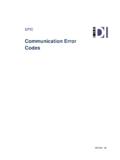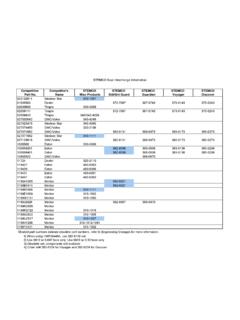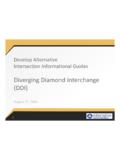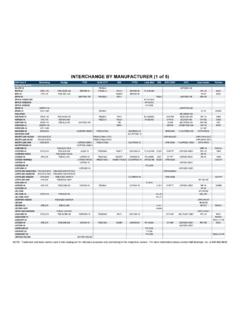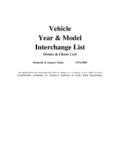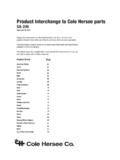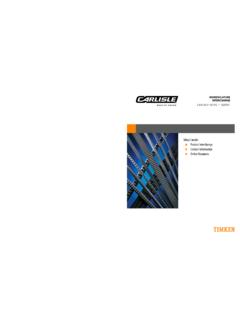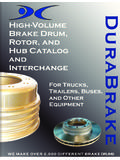Transcription of Electronic Data Interchange
1 data Interchange plc Electronic data Interchange Issued: 14 March 2006 Copyright data Interchange Plc Peterborough, England, September 2005. All rights reserved. No part of this document may be disclosed to third parties or reproduced, stored in a retrieval system, or transmitted in any form or by any means, Electronic , mechanical, photocopying, recording or otherwise, without the prior written permission of data Interchange Plc. Table of Contents Electronic data 5 What is EDI?.. 5 Urgency The Move To Standardised The EDI 7 VDA Syntax 9 Service Segment Delineation Streams of Message 12 EDI Codes and 14 EDI Routing The Hierarchy of Node EDI codes in ODEX EDI Codes for Clearing The Makeup of an Odette/EDIFACT EDI The Makeup of a Tradacoms EDI VDA EDI Encoding 19 ASCII 20 File encoding in DI Electronic data Interchange 4 Electronic data Interchange What is EDI?
2 For several hundred years, commerce has been based upon the movement of written documents. These documents contained the information that one company needed to convey to another company in order to do business. Over a period of time the documents started to take on standard names such as Invoice, Credit Note and Order. However, the documents were certainly not of any standard layout. They did not need to be because the recipient was always a human being and humans have the ability to read, interpret and rationalise. About all that could be said of an invoice document, for example, was that it would contain header information about the parties involved, detail lines about the products, quantities and prices, and finally some totalling information. In the early 1950s, computers started to be used by large companies for their accounting and payroll needs.
3 Throughout the following decades, computers rapidly took over task after task until they were involved not only in accounting, but in production, administration and all other areas of commerce. But one thing did not change. The computers still produced printed documents in various non-standard formats. This situation was not too bad for those sending a document but was much worse for the receiver. Many documents must be sent from one company s computer to their trading partner s computer. Computers cannot easily read written documents, and getting them to understand what they have just read is an almost impossible task, so the receiving company would have to employ personnel to re-key the information from the received documents into the company s computer system. Urgency Issues The time factor was also a problem.
4 The company sending the document had printed it in a few seconds. It was placed in an envelope and then posted. The document would probably take several days to reach the Electronic data Interchange 5 final destination (always with the possibility of accidental loss) where the envelope would be removed and the document presented for keying in to another computer. For a long time, managers had been thinking how good it would be to have Just in Time production techniques, where a supply lorry would be able to arrive at the production line gates just in time to be unloaded and its contents taken directly to where they were needed on the production line. They dreamed of an end to costly warehousing and stock control. But these methods were impossible while the trading partners were still using the post. Lorries would be arriving at the wrong times, or not at all, causing the production lines to stop and chaos to reign, all because of the delay in the information flow.
5 Communications Part of the answer to these problems was computer communications and the need to make one trading partner s computer talk to another. Communications have been in existence since the early days of computers. A file can be transmitted from one computer to another, either over a normal telephone line or over a Leased Line that is continuously in use and dedicated to computer communications. Many commercial products exist that can move files in this way. Communications did not solve the whole problem though. Once a file is received it needs to be understood by the receiving computer. Items of information must be in the exact place that the computer is expecting them. If just a single character is out of place, the whole file will become uninterpretable by the computer. In the early days of communications, trading partners had to spend a great deal of time agreeing exactly where each item of information would be stored in the files that were transmitted.
6 These agreements were only active for one trading partner. Start trading with another partner and the requirements would change slightly, a larger product code would perhaps be needed, or a different method of pricing, but the whole negotiation and agreement process had to take place all over again. It kept the programmers busy but did little for the company profits. The Move To Standardised EDI The solution was EDI, Electronic data Interchange , a standard method of transferring commercial information between computers. The Message EDI ( Electronic data Interchange ) files contain information, in one of many possible formats, pertaining to commercial documents. For example, a paper invoice will always contain certain information whatever the company or country of origin. It will contain the originating and receiving company s information such as addresses, telephone numbers, contacts, etc.
7 It will then have a section where the items to be Electronic data Interchange 6invoiced are laid out in a formatted manner, with prices and quantities, and finally it will have a totals section. All this information may be contained within an EDI file of a pre-defined format, so that whoever receives the file will be able to understand it and automatically pass this information into their own in-house systems, irrespective of the type of computer or the systems that they are running. The Standards Bodies A number of different standards bodies were created to define both methods of communications and the layout of standard trading documents, so that simple and cost effective Electronic trading could take place. The main document standards with which we will be concerned are EDIFACT, Tradacoms and ANSI X12, but before going into detail about the standards themselves, here is a short background to the development of the UK documents standards bodies.
8 The earliest development of standards, usually for particular sectors of industry, was carried out in the late 1970 s under the auspices of the EAN. EAN is the International Article Numbering Organisation dealing with EDI standards. It acts as an umbrella group for the various national Numbering Organisations. In 1998, as a result of the merger of the Article Number Association (ANA) and the Electronic Commerce Association, the was launched as the EAN Numbering Organisation for the UK. More recently, in February 2005, the has become GS1 UK. This is in line with the global re-launch of EAN International as GS1. The first UK message standards were published by the ANA in 1982, having been tested and developed since 1979. Over 90% of all UK trade EDI takes place using standards from the ANA, whose members include representatives from manufacturing, distribution, wholesaling, service and retail organisations.
9 The ANA standards use the two key syntaxes: UN/GTDI (General Trade data Interchange ), which forms the basis for TRADACOMS messages; UN/EDIFACT (EDI for Administration Commerce and Transport), which is the basis for EANCOM and UK EDIFACT messages. Further details about message syntax are in the sections that follow. The EDI Model There are three logical levels or layers of standards required to achieve EDI information transfer, each layer having its own controlling standards organisations (although some organisations may define more than one layer). This structured approach to EDI allows for the maximum flexibility Electronic data Interchange 7 and also enables future developments in technology and standards to be easily incorporated. From the lowest layer upward, these three layers are: The Communications Standards - Defining just how the data is to be transferred from the sender to the receiver.
10 The Syntax Standards - Defining what overall standards format the EDI file will be in. The Message Standards - Defining exactly what the message is and what information is to be placed where within this message. These standards are going to be further described in the following sections but it is important to remember that whatever standards are used within each layer, the layering process is required to allow flexibility. For example not all users will wish to use a specific communication protocol; some may even wish to copy the data onto a floppy disk and send it in the post! So the communications level is now a floppy disk but the higher levels still remain. This principle of multiple methods of achieving the same goal is found over and over again within the EDI regime. It is not an attempt at duplication but is designed to give users the best possible solution and flexibility in all cases.
